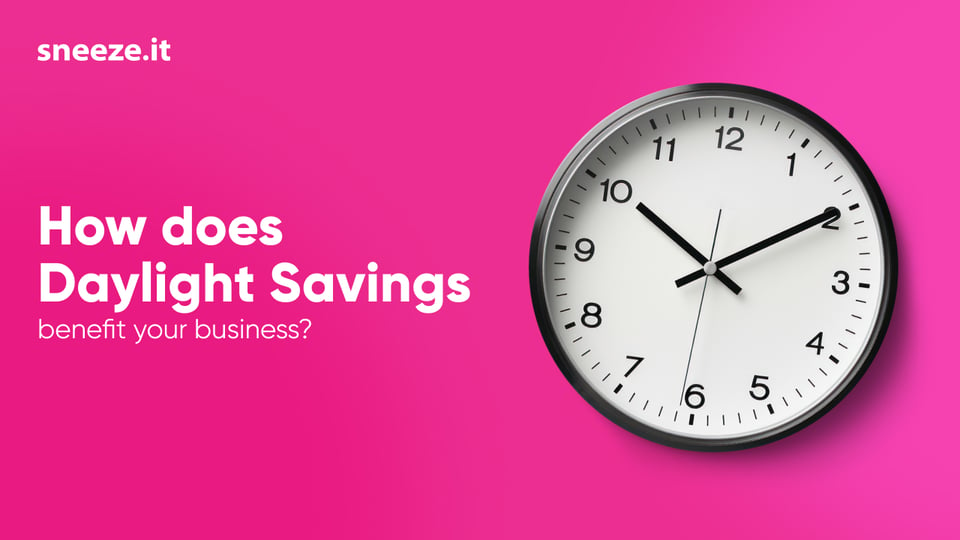As someone who gets to analyze advertising over time, I approach the topic of the spectrum of...
Shining a Light on Daylight Savings Time: Origins, Annual Routines, and the Bright Side for Businesses

As the leaves turn a golden hue and the air carries a hint of autumn crispness, a familiar ritual is on the horizon for many: the transition out of Daylight Saving Time (DST). This biannual clock-changing tradition has sparked debate, curiosity, and even confusion. But beyond the extra hour of sleep in the fall or the lost sixty minutes in the spring, DST carries a history rich with intention and benefits, especially for the business community. So, let's turn back the hands of time to explore the origins of DST and illuminate the reasons behind its implementation, as well as how it benefits businesses each year.
The Dawn of Daylight Saving Time
The concept of DST is often misattributed solely to Benjamin Franklin. While Franklin, during his stay in Paris, suggested that Parisians could economize on candles by rising earlier to use morning sunlight, he did not propose changing the clock. The real father of DST is George Vernon Hudson, a New Zealand entomologist, who in 1895 formally proposed a two-hour daylight-saving shift to the Wellington Philosophical Society. The idea was to provide more sunlight during waking hours.
However, it was Germany during World War I that first implemented DST in 1916, to conserve coal by minimizing the use of artificial lighting. Allies and foes alike soon adopted this time-tinkering practice, finding that it benefited not just energy conservation efforts but also everyday life.
Why We "Spring Forward" and "Fall Back" Each Year
The primary purpose of DST is to make better use of daylight during the longer days of summer. By ‘springing forward’ an hour, we move an hour of daylight from the morning to the evening. The practice is widespread in regions away from the equator, where there is a significant variation in daylight hours throughout the seasons.
In the United States, the Uniform Time Act of 1966 standardized the length of DST, though states can opt out. Today, most Americans set their clocks forward one hour near the start of spring and adjust them back in the fall. This annual routine is more than just a temporal tradition; it is a conscious alignment with the Earth's natural rhythm.
The Bright Side for Businesses
Daylight Saving Time is more than just an energy policy or a seasonal quirk—it has tangible benefits for businesses. Here’s how:
- Extended Shopping Hours: More daylight in the evening hours means consumers are more likely to stop and shop after work. Retail businesses see a spike in sales during DST, as the longer days encourage more foot traffic.
- Boosted Productivity:The additional daylight has been associated with improved mood and vitality, which can lead to increased productivity in the workplace. Employees tend to feel more energetic when it's lighter outside, potentially improving workplace morale and output.
- Energy Savings: The initial purpose of DST was to save energy, and this still holds to some extent. With more natural light available, businesses can cut down on artificial lighting costs, though modern heating and cooling considerations complicate this picture.
- Encouragement of After-Work Activities: DST supports a thriving service industry. Restaurants, parks, and recreational facilities benefit from extended daylight hours, as people are more inclined to dine out, engage in sports, or attend events when the sun sets later.
- Tourism Flourishes: In regions with significant tourism industries, longer daylight hours invite tourists to maximize their sightseeing and experiences, directly benefiting local businesses and the broader tourism sector.
Despite its benefits, DST is not without controversy or challenges. Critics point to health risks associated with the time change and question the modern-day energy savings. Furthermore, not all businesses benefit equally; for instance, those in the entertainment and broadcasting sectors sometimes see a dip in indoor activity due to the change.
Nevertheless, it's worth recognizing that Daylight Saving Time, much like the seasons themselves, brings both change and opportunity. Businesses that anticipate and adapt to these temporal shifts can often find ways to turn the "extra hour" into extra profit. As we adjust our watches and clocks, let's also adjust our perspectives to find the bright side of DST.
In conclusion, Daylight Saving Time remains a pivotal marker of seasonal change, a remnant of historical energy conservation efforts, and a significant factor in the economic ebb and flow for businesses. Whether you're an early riser enjoying the morning light or a business leveraging the extended evenings for customer engagement, DST is a time-tested tradition that, at least for now, keeps ticking along with the times.
Want to learn how Sneeze it can help you take your marketing to the next level? Schedule a meeting below!





